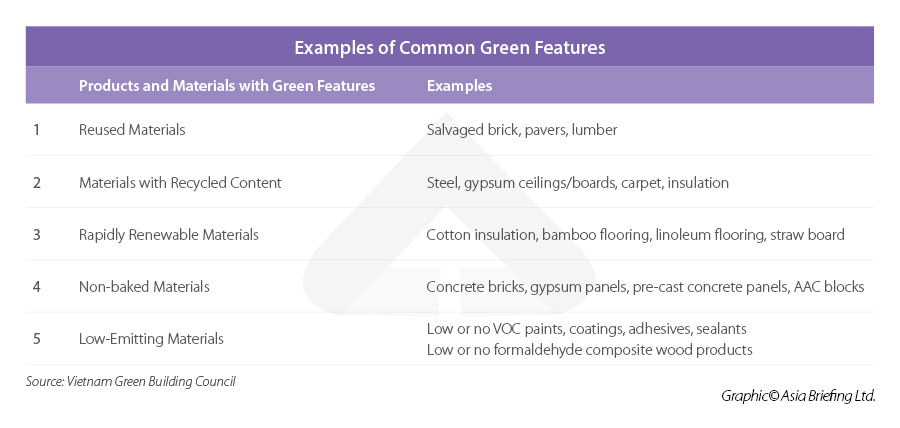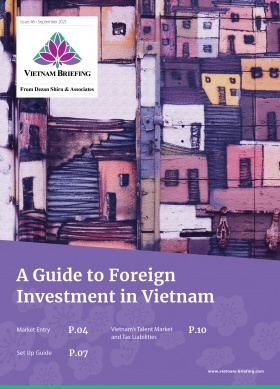Green Buildings in Vietnam: How Sustainable Are They?
This article is part of our partnership with the Green Economy Forum & Exhibition 2022, organized by EuroCham Vietnam, supported by Dezan & Associates Vietnam.
- Green buildings are swiftly building momentum in Vietnam, representing significant investment opportunities for investors.
- Vietnam has extensively collaborated with foreign entities, including the UNDP, and the World Bank to green up its cities and wants to continue on this trend.
- Green building materials are opening new market segments in Vietnam with significant room for design innovation.
Vietnam’s growing economy, increasing population, and rapid urbanization have increased pressure on its natural resources. The country’s enormous coastline makes it vulnerable to the effects of climate change and rising sea levels. Thus, its government has realized the need to transition towards making its urban development smarter and more sustainable.
Sustainable construction
According to the Ministry of Construction (MoC), Vietnam’s housing demand will increase by 70 million square meters each year, equivalent to 17,500 buildings of 30 floors by 2030. However, by the end of 2021, Vietnam recorded just over 200 green building projects.
All building types, including commercial, institutional, and residential, use a significant proportion of a country’s resources in their lifespan. In Vietnam, buildings use 17 percent of the country’s fresh-water, a quarter of its wood harvest, 30-40 percent of its energy production, and half of its raw materials.
Sustainable construction is a valuable solution to slow down human activities’ detrimental effects on the environment. Structures identified as green are highly efficient in utilizing energy and materials – subduing their adverse implications on public health and the ecosystem.
These buildings – created for a long lifespan – require eco-friendly materials characterized as either non-toxic, recycled, efficient, energy-saving, long life-cycle, or less polluting to the environment.
Rising opportunities in Vietnam’s green architecture
According to International Finance Corporation (IFC), the country’s green buildings sector is almost a US$80 billion investment opportunity. Potential investment in renewable energy totals US$59 billion, with over half of this (US$31 billion) in solar photovoltaic (PV) technology and another US$19 billion for small hydropower projects.
Vietnam’s climate-smart business investment potential is also estimated at US$753 billion, with the majority coming from the country’s transportation infrastructure needs by 2030 as per IFC.
The Green Infrastructure Investment Opportunities (GIIO) report presents major trends and developments for green infrastructure and energy. It showed significant investment potentials adding close to US$100 trillion worldwide for the 2019-2030 period. It asserted that Vietnam would need to adopt greener infrastructure to compensate for the environmental implications of its economic development – such as the increase in energy consumption, urban development, and greenhouse gas (GHG) emissions.
As per VGBC, demand from consumers and the market is the prime driver of green buildings in Vietnam.
Government policies supporting green buildings
In the past five years, Vietnam’s MoC, with the support of UNDP’s Global Environment Facility is realizing a project to enhance Energy Efficiency in Commercial and high-rise residential Buildings (EECB).
EECB has exhibited several solutions to improve existing and new buildings’ efficiency. These solutions saved 25-67 percent of energy for each building, coming at the expense of up to three percent in addition to the investment cost. The aforementioned numbers assume a maximum payback period of five years for calculations, as per the UNDP programme.
As a part of this project, the MoC has updated the economic and technical norms in the National Technical Regulation on Energy Efficient Buildings. This policy prescribes the mandatory technical requirements for the design, construction, or renovation of skyscrapers with a total floor area of 2,500 square meters and above.
Additionally, the EECB project coordinates research and proposals for the amendment of the Law on Construction, especially regarding policies, mechanisms, and regulations on efficient and cost-effective energy use.
By 2030, Vietnam has committed to reducing greenhouse gas emissions by nine percent compared to business-as-usual (BAU) estimates. This number can increase to 27 percent with international support. These commitments are part of the Nationally Determined Contributions (NDCs), which form the core of the 2015 Paris Agreement. The final goal of NDCs is to regulate global warming from 1.5 to 2°C above pre-industrial levels. NDCs prescribe what changes a country needs to implement to control greenhouse gas emissions and slow down climate change.
This has also been amplified by Vietnam’s commitment to achieve net-zero carbon emissions by 2050.
Laws governing green buildings
Vietnam’s construction sector has enacted the following policies to facilitate the construction of green buildings:
- Resolution 55-NQ/TW on the Orientation of the National Energy Development Strategy of Vietnam to 2030, with a vision to 2045;
- Resolution 140/NQ-CP on the Action Plan to implement the Resolution 55-NQ/TW, which specifies tasks for saving energy and improving efficiency in the construction sector;
- Revised Law on Construction (2020);
- Vietnam Energy Efficiency Programme 2019-2030;
- Construction materials development strategy of Vietnam in 2021 – 2030, with a vision to 2050;
- Decision 1393/QD-TTg on “National Green Growth Strategy”;
- Decision 403/QD-TTg on “Actions to implement the National Green Growth Strategy”;
- Decision 419/QD-BXD on “Plan of actions of the construction industry to implement the Green Growth Strategy”; and
- Decision 3457/QD-UBND on “Regulating the management of urban spaces and urban architecture of the current Ho Chi Minh City downtown area”.
In recent years, the MoC has actively advised and submitted to the government and the Prime Minister action plans and also issued many mechanisms, policies, many schemes, and strategies to encourage businesses and people in promoting production and use of unburnt building materials, green, environmentally friendly building materials and energy-efficient.
Currently, regulatory restructuring focuses on cement, ceramics, sanitary wares, construction glass, clay-fired bricks, unburnt construction materials, sand, and concrete.
Advancement of green cities a priority
Over 30 cities, including Hanoi, Ho Chi Minh City, and Da Nang, have made steps to become green equivalent. In this direction, Vietnam introduced the urban green growth development plan, urban green growth indicators, and a smart city strategy.
The five pillars of developing smart and sustainable cities are as follows:
- Sustainable quality;
- Reducing energy consumption;
- Saving resources;
- Health and safety; and
- Reducing environmental impact.
Certification systems
To be acknowledged as green, a building must meet several sustainable development requirements. The criteria include attaining high efficiency in energy and material usage, lessening the impact on the environment, and adhering to safety standards.
There are diverse green building certification systems around the world. The standards, including the Leadership in Energy and Environmental Design (LEED), World Bank’s Excellence in Design for Greater Efficiencies (EDGE), and Singapore’s Green Mark, are most widely adopted.
The LEED standard focuses on developed economies, and the EDGE system emphasizes lowering energy and material consumption. The Green Mark system bases itself around the developing economies’ construction market. VGBC has developed LOTUS – a standard specifically for the needs of Vietnam.
As per IFC, by September 2021, Vietnam had 201 certified green buildings, equivalent to 5.3 million square meters, an increase of 30 percent over the same period last year. Of that, EDGE accounted for half of the total number, followed by LEED and LOTUS at 44 percent and 7 percent respectively.
Green architecture on the rise
In the past decade, the popularity of buildings built around the green concept has caught pace. Several leading property developers in Vietnam, including Vingroup, Phuc Khang, Gamuda Land, and Sun Group, have begun launching eco-themed residential projects. Vietnamese conglomerate Vingroup has launched four real estate projects in the country.
Another mammoth implementation of the green concept is the Mui Dinh Ecopark located in Ninh Thuan. This eco-park spanning over vast 700 hectares consists of seven hotels with 7000 rooms, over 500 ocean-facing villas, a theme park, a casino, and several other recreational facilities.
Feliz En Vista, a 35-story skyscraper in Ho Chi Minh City has been developed by Singapore’s Capitaland Group. This building’s design reduces its HVAC systems’ energy consumption by roughly half and lighting by 70. These savings translate to savings of nearly 4800 MWh of electricity, 3900 tonnes of carbon dioxide from being emitted, and energy cost saving of roughly US$600,000 each year. These changes increased the building cost by two percent with an estimated payback period of 1.5 years.
Challenges in the green buildings sector
Vietnam’s critical roadblocks to green building adoption include the lack of adequate support in policies, green building specialists, and higher initial investment. As per VGBC, misinformation was one reason in the past for Vietnam’s delayed adoption of green buildings, with the perception of up to a 25 percent price increase for constructing a green equivalent.
As per MoC officials, construction for green buildings can cost up to five percent more. For developers, contractors, and users, going green may mean a minor bump in price but in exchange, they reap long-term benefits from the building’s sustainability, such as lower maintenance charges and a shorter payback duration.
Sustainable building materials and techniques
Green buildings have extensive green cover around them compared to the usual architecture that crams several buildings in a small area – keeping the locality cooler. These buildings use natural wind flow to ventilate their indoors. Such buildings have large windows that allow plenty of light in the rooms, minimizing the need for artificial lighting during the day.
The windows use glass that slows down the outside heat from seeping into the building. Insulating the building’s roof keeps the sunlight from heating the top few floors. Design changes like these allow the buildings indoors to naturally stay cooler and brighter. They significantly improve the residents’ living quality while minimizing energy consumption.
Takeaways
Green buildings can be potentially profitable for foreign investors as this type of housing is only set to grow in the future. In order for Vietnam to effectively house its urbanizing population, green and affordable housing will have to be at the forefront of construction in the mid to long-term future.
About Us
Vietnam Briefing is produced by Dezan Shira & Associates. The firm assists foreign investors throughout Asia from offices across the world, including in Hanoi, Ho Chi Minh City, and Da Nang. Readers may write to vietnam@dezshira.com for more support on doing business in Vietnam.
We also maintain offices or have alliance partners assisting foreign investors in Indonesia, India, Singapore, The Philippines, Malaysia, Thailand, Italy, Germany, and the United States, in addition to practices in Bangladesh and Russia.
- Previous Article How the Russia-Ukraine Conflict is Affecting Businesses in Vietnam
- Next Article Vietnam Increases Overtime Hours Until Year End









